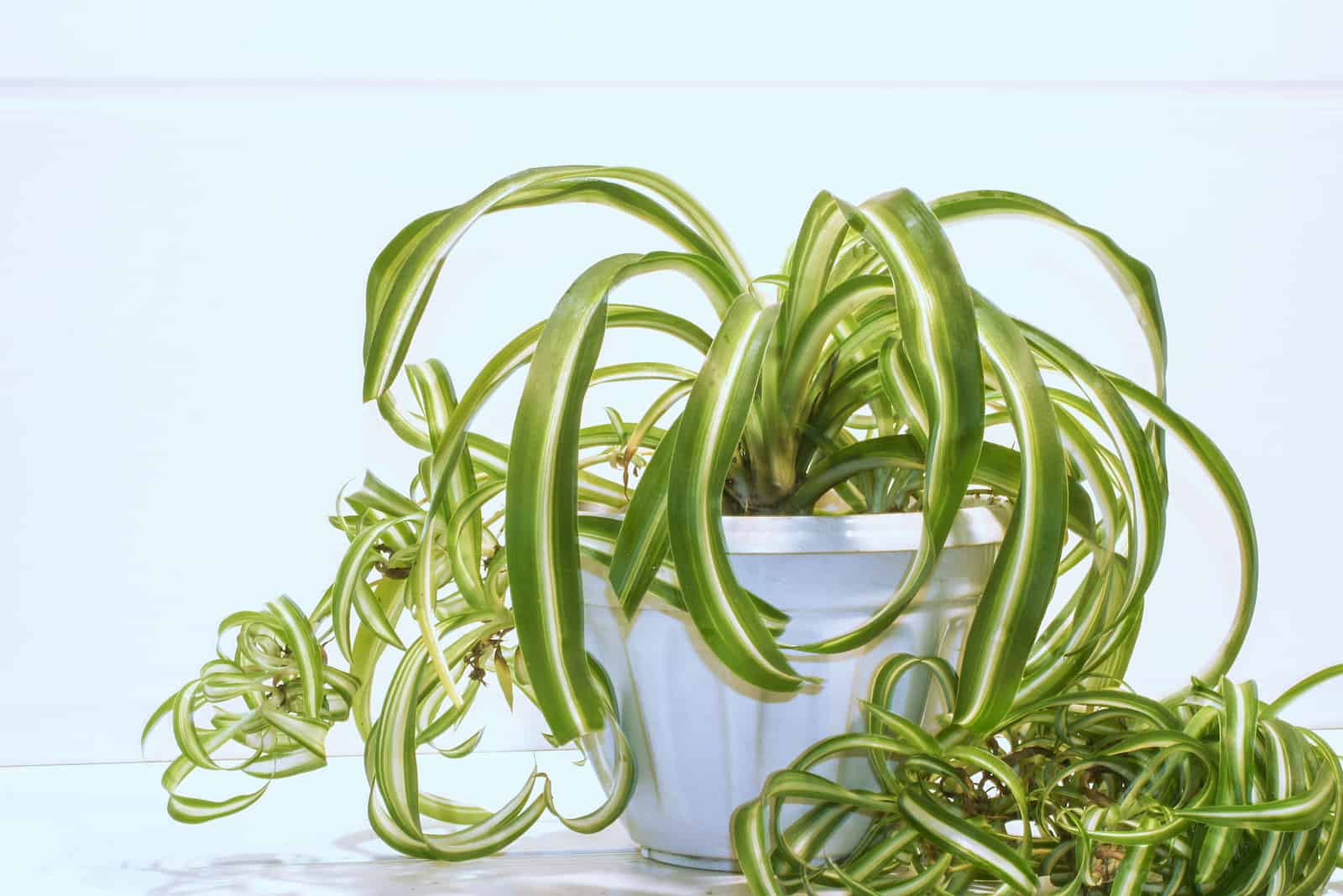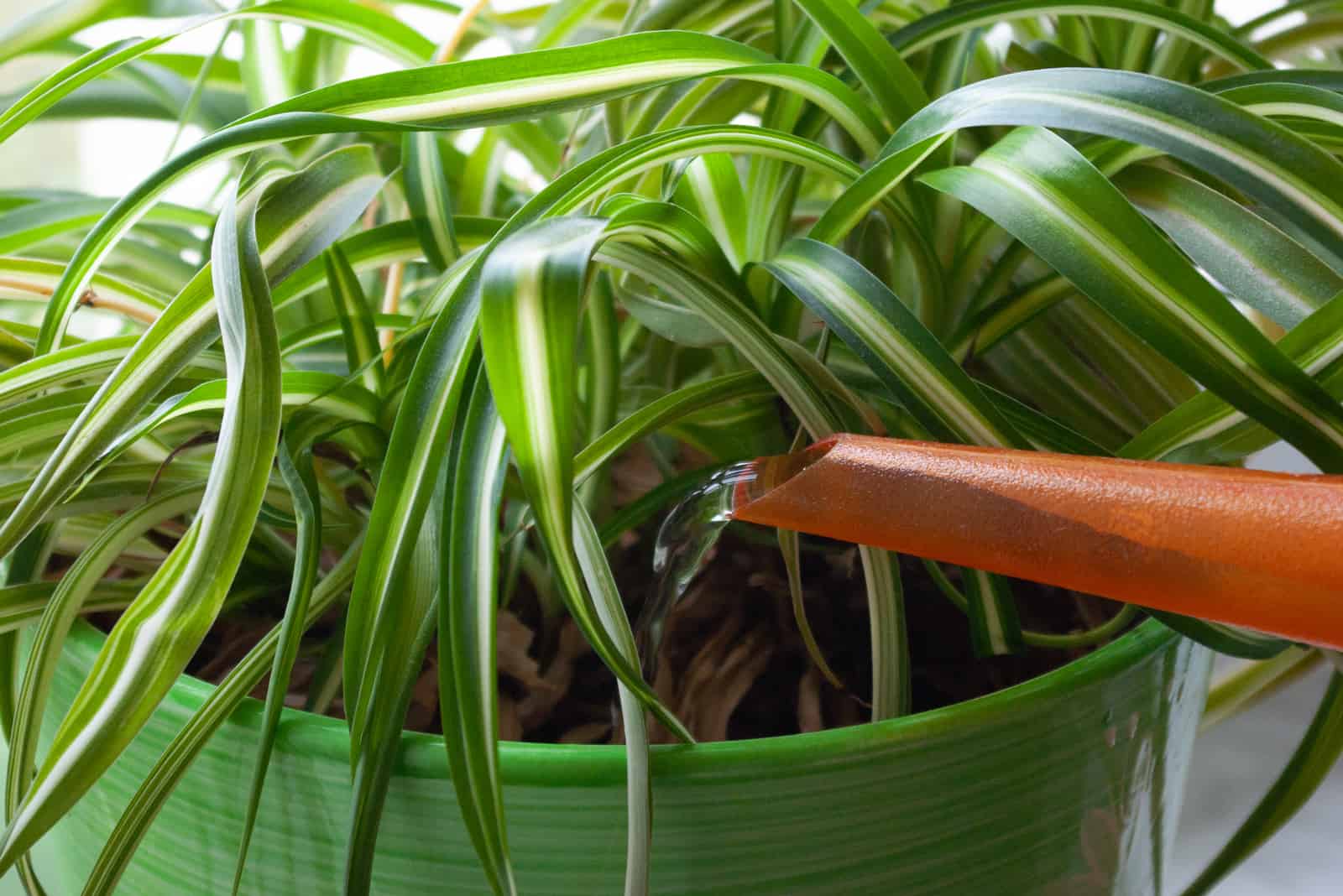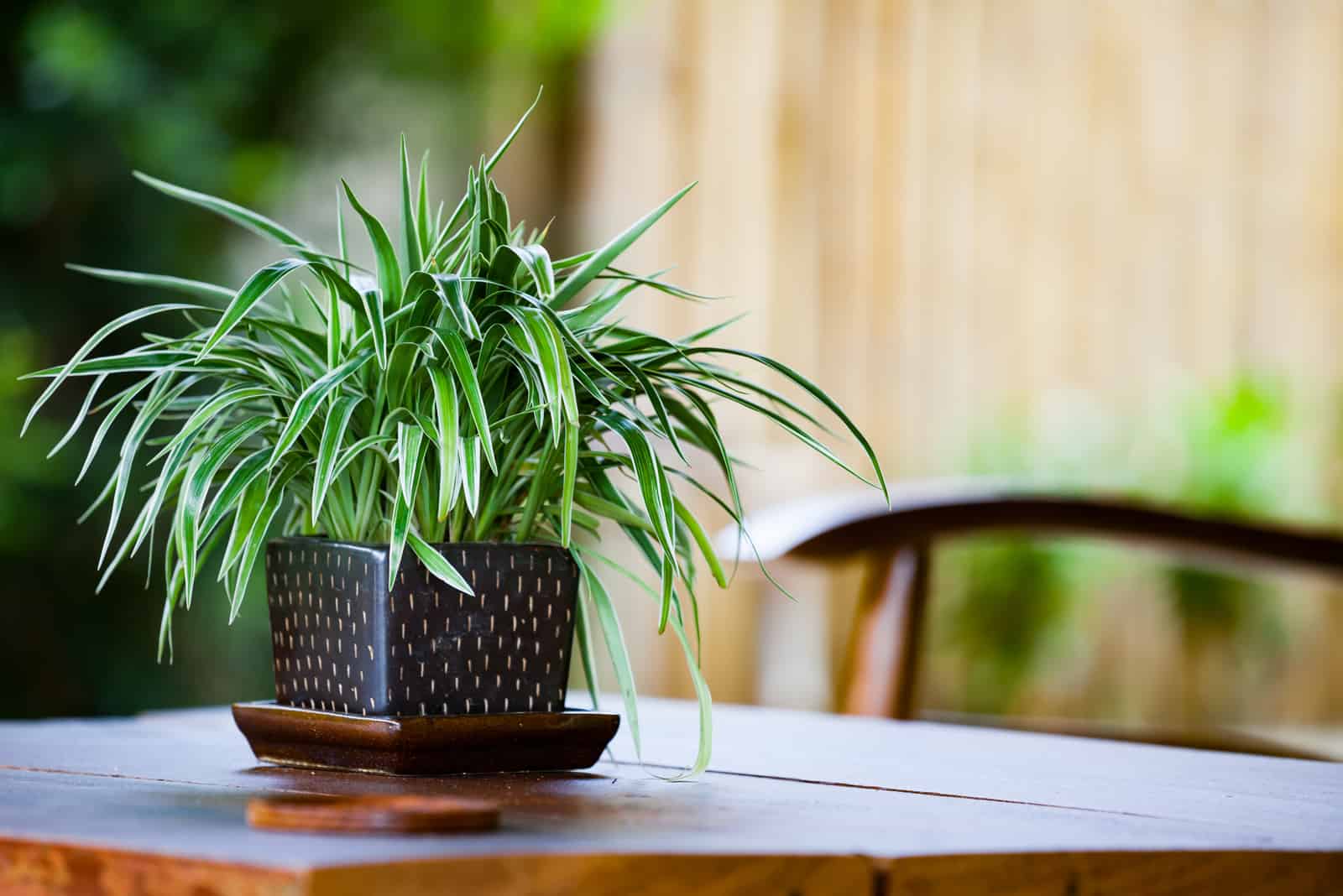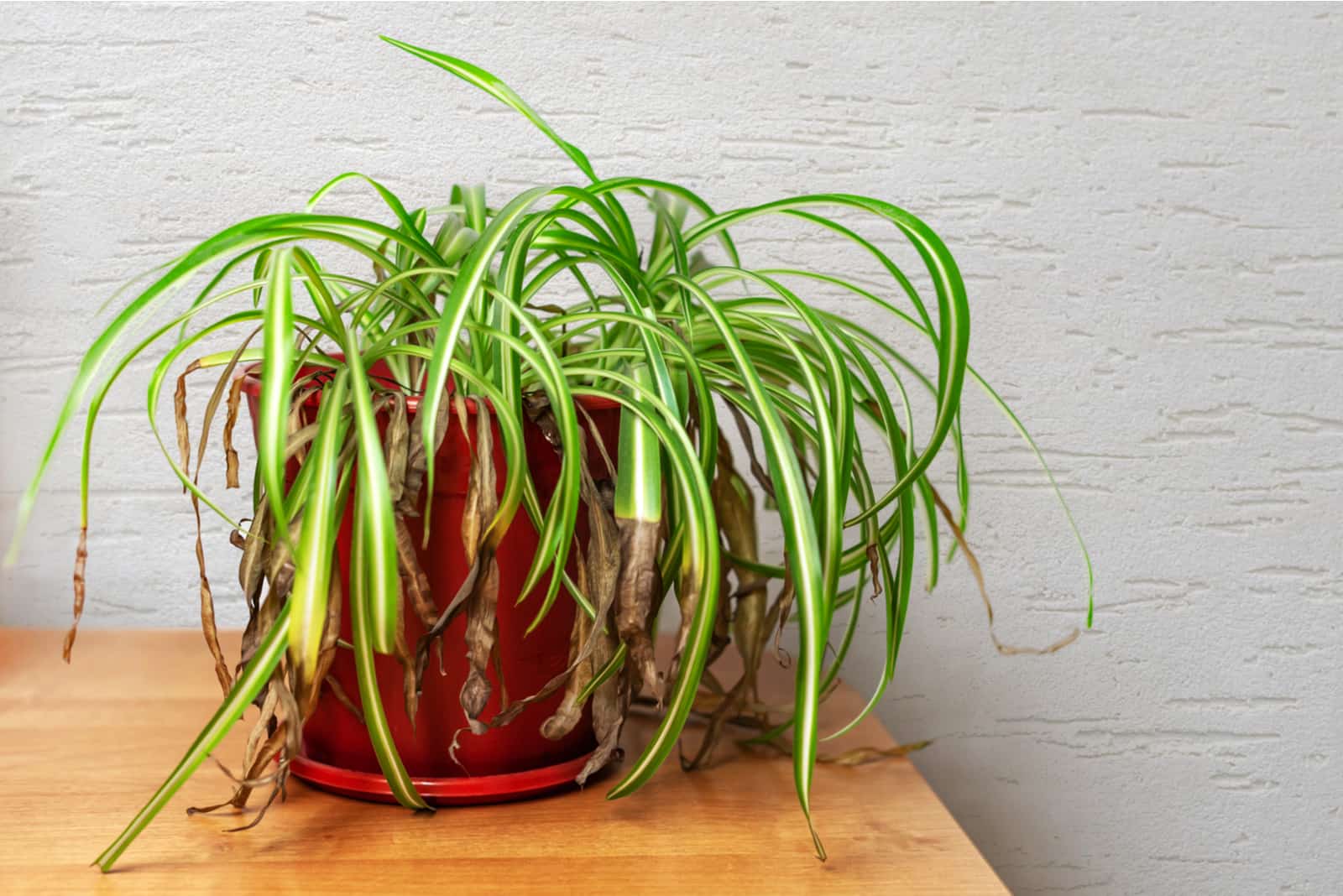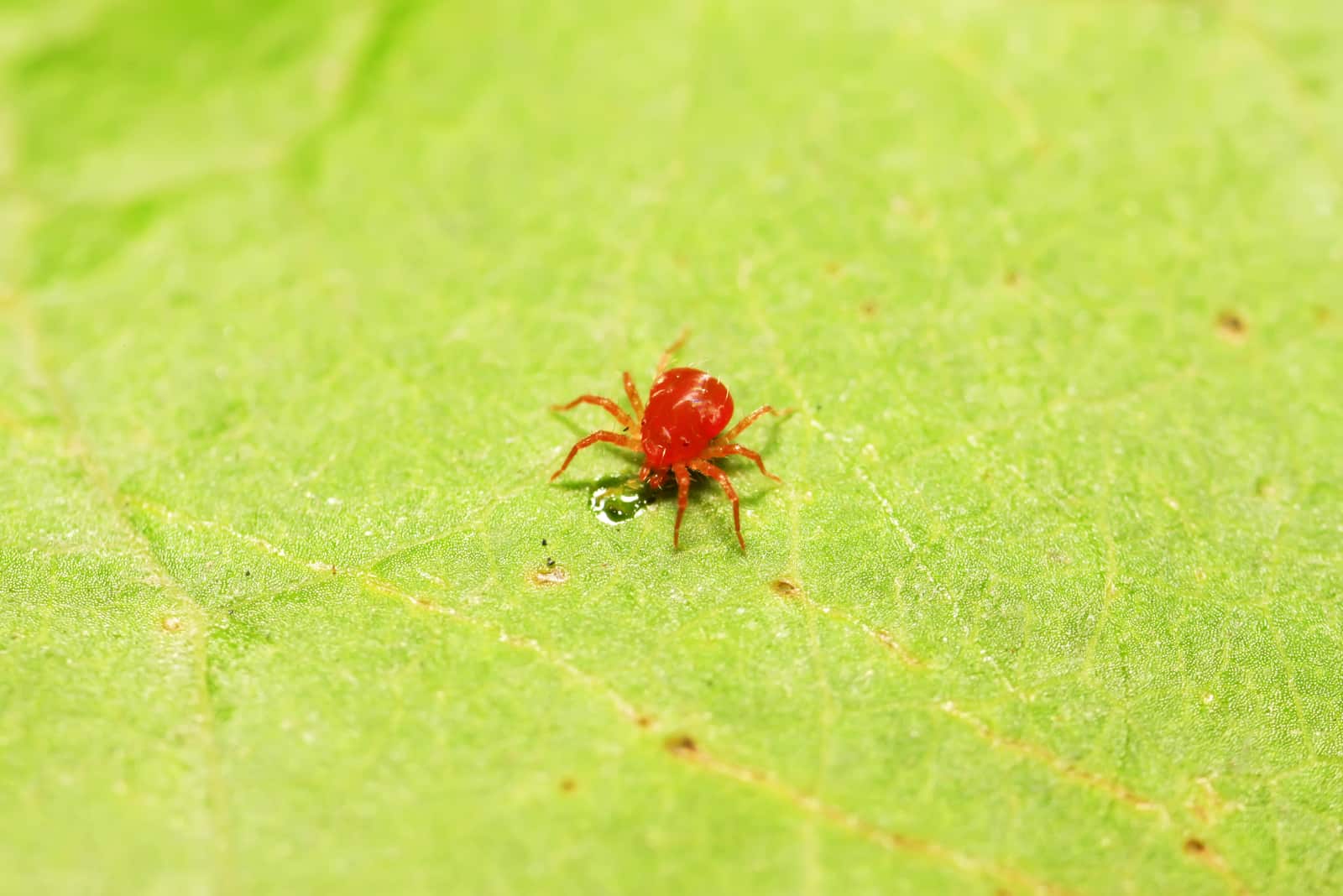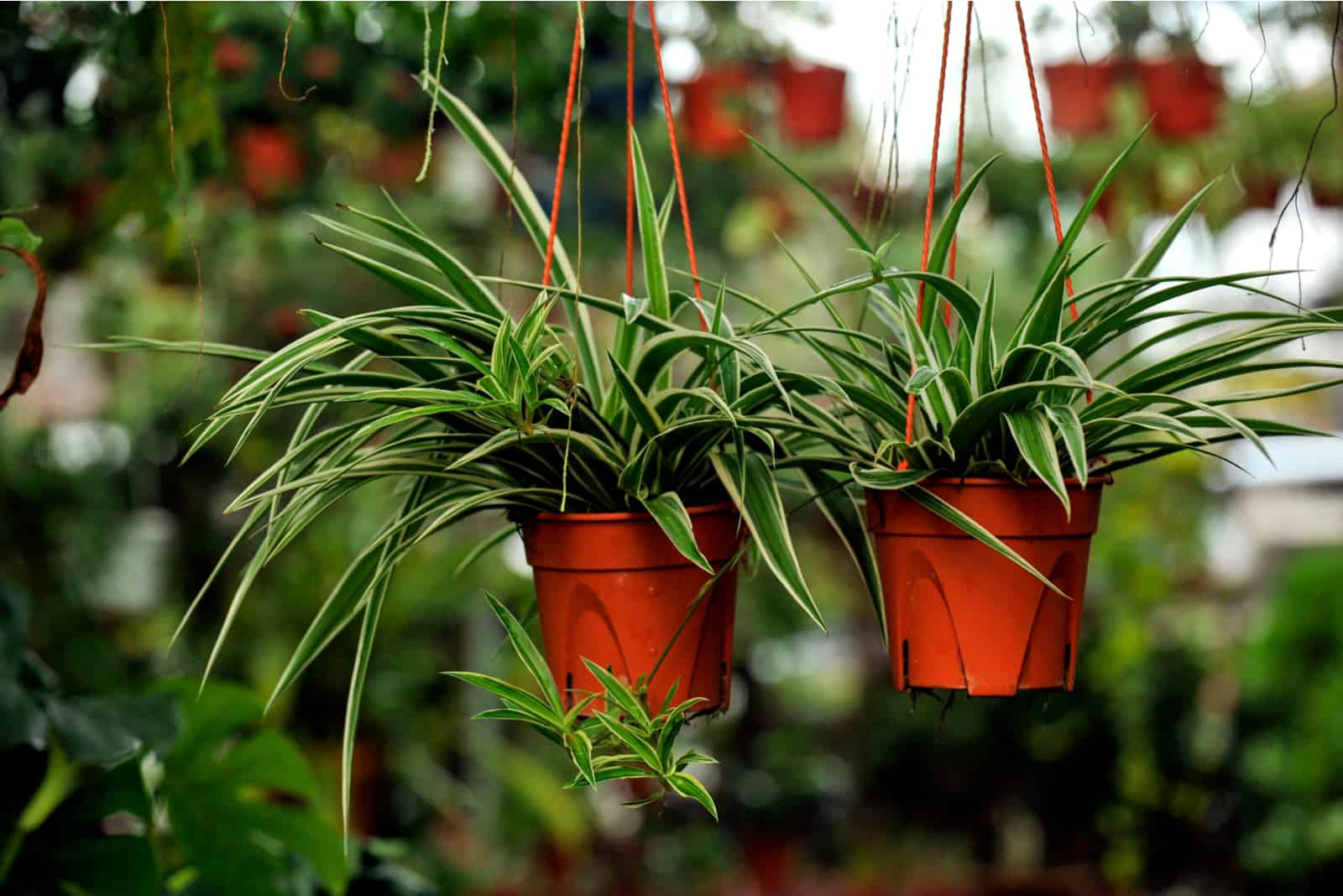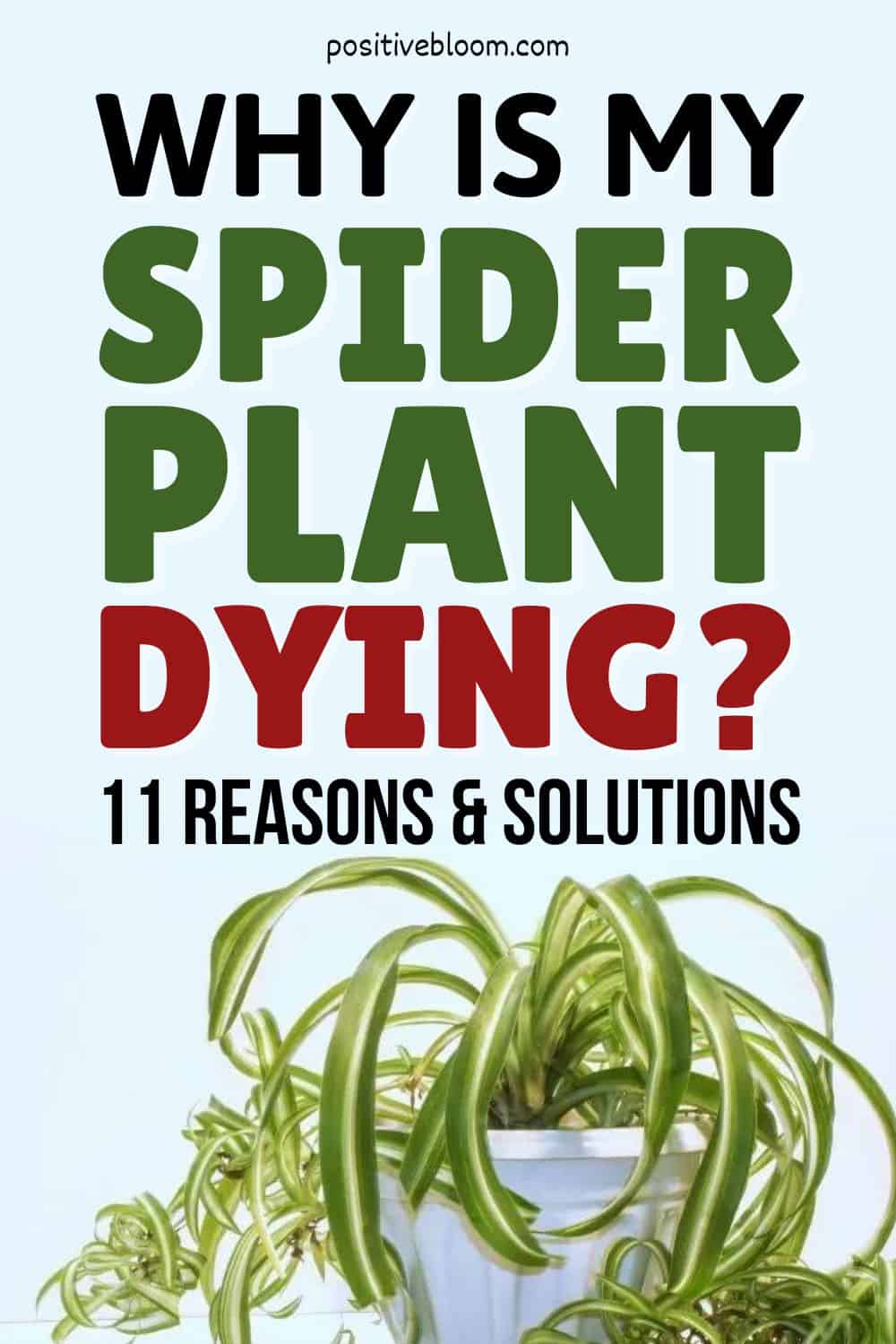“Why is my spider plant dying?” is a question that’s been bugging me for quite some time. The most common reasons are improper watering and lighting, but what if that’s not the case?
I decided to investigate the matter a bit further, and was really surprised by the number of things that can go wrong, especially because spider plants aren’t the most delicate things on the planet.
Before we learn more about the things that can go wrong with these houseplants, let’s look at their main info:
[table id=205 /]The sections below will discuss the leading causes of a dying spider plant as well as solutions to those issues. However, prevention is the best cure, so try to avoid these things.
Let’s begin!
Why Is My Spider Plant Dying? Reasons And Solutions
Even though the purple spider plants’ care guide (and care guides of many other spider plants) is straightforward and these plants can handle a lot, they still have their limits, and once you cross them there’s no turning back.
Actually, there is, but it’s a rather painful process that can be avoided by tending to your plant’s needs.
However, sometimes we just get caught up in our own problems and forget to check up on our plants, which is when problems occur!
Your spider plant may appear as if it’s dying due to improper watering, lighting, and fertilization, but there are other issues like small pots and environmental stressors that can harm your plant as well.
It’s useful to know all these causes so you can try and avoid them. However, these sections will also bring you solutions to these problems if you find yourself and your plant in a pinch.
So, let‘s see what these spiders have in store for us!
1. Overwatering
Overwatering is the leading issue of a dying spider plant. This indoor plant doesn’t require too much water, especially in winter when it goes dormant.
However, new growers often have a fixed watering schedule that they zealously follow without listening to what their plant is saying.
Your plant won’t die if you give it too much water once or twice, but if you do so too regularly the water will accumulate in the soil. The problem gets worse when you don’t have a pot with drainage holes because the water won’t be able to drain properly.
Overwatering leads to root rot, a fungal disease that can kill your plant if left untreated. Infected leaves cannot absorb nutrients and oxygen from the soil, which deprives your plant of the essential resources it needs to survive.
Overwatered spider plants may have brown leaf tips or spots and the foliage can turn yellow. It’s also common to see shriveled, wilted, and curly leaves. In severe cases, you may even notice an unpleasant smell coming from the pot, a rotted plant base, and mushy leaves.
Solution To Overwatering
It’s not all over if your plant is diagnosed with overwatering and root rot; there are still some things you can do to save it.
The first thing you should do is repot your plant using fresh, well-draining soil and a container with some holes in the bottom so that the excess water can drain.
Reveal the roots, and if they look dark, brown or black, and soggy and mushy, you should remove them. Cut away all infected roots so the infection doesn’t spread, treat the plant with a fungicide, and then repot your plant into a new pot with fresh soil.
If overwatering is a novel problem, you don’t have to go through all the lengths of transplanting your plant. You can simply reduce watering and water your plant only when the topsoil is dry.
The proper technique is to irrigate your plant until you notice that the water has started accumulating in the saucer. Allow the excess water to drain and remove it from the saucer within half an hour.
2. Underwatering
Underwatering is another deadly issue, but it’s much less frightening and much easier to cure than overwatering.
These plants are much more tolerant of low-water conditions, but they still need enough moisture to grow and develop. Without water, spider plants cannot absorb the nutrients from the soil they need to grow healthy.
Both underwatering and overwatering are known as water stress and are more likely to happen in the changing seasons when your plant either wakes up from dormancy or goes dormant.
It is necessary to adapt watering frequency to the needs of your plant; water it more during spring and summer and less in fall and winter.
Dry soil and droopy, wilting plants are common symptoms of underwatering. Your spider plant leaves may also start fading and losing their attractive colors, so make sure you water them regularly!
Solutions To Underwatering
The solution to this issue is pretty simple – water your plant frequently and whenever it needs it!
You should always check the soil before watering spider plants as you don’t want to overwater it either, but generally speaking you should water this plant once a week during its growing season and once every other week when it enters dormancy.
3. Poor Water Quality
Believe it or not, there is such a thing as the best water for plants. Tap water isn’t the best choice due to high chlorine and fluoride levels, and even though it might be safe for us to drink it, it can be harmful to your plants.
These chemicals can build up in your plants and truly harm them. Fluoride is known to affect seed germination and photosynthesis, and interfere with the absorption of calcium. Chlorine kills the beneficial bacteria and microbes in the soil that supply nutrients to the substrate.
You can recognize chlorine and fluoride poisoning by scorched-looking leaves. Foliage will also be smaller because it cannot photosynthesize and absorb nutrients properly. Older leaves frequently get brown tips and spots, while the entire leaf starts looking almost bleached and the younger leaves turn yellow really quickly.
Solution To Poor Water Quality
Unfortunately, affected and discolored leaves cannot get back to health, so you will need to snip them so they don’t waste your plant’s energy, which can be diverted to the production of new leaves.
You should turn to distilled water, which is pure and clean from all chemicals found in tap water that may harm your plant.
4. Low Humidity
Another cause of a spider plant dying is low humidity. This plant is low-maintenance, but you still have to meet its basic needs, which include a high humidity level.
Plants lose lots of moisture through transpiration, and if the humidity levels are higher, the transpiration rate is lower.
Humidity is usually lower in winter when heaters are on and it’s cold outside, but AC can significantly lower the air moisture levels as well. Wind and draft also make the air drier, so keep this in mind when deciding where to place your spider plant.
Leaves drying and turning brown is a common sight when your spider plant doesn’t get the air moisture it requires, but there are some things you can do to prevent this.
Solutions To Low Humidity
The best solution to low humidity levels is investing in a trustworthy humidifier. There are some great deals on Amazon, but you can get a good humidifier pretty much anywhere.
However, they aren’t the only things that help with humidity. You can provide excellent spider plant care by moving it to a room with more humidity, such as a bathroom or kitchen.
There has been speculation about whether pebble trays actually work, and even though they can raise the humidity a bit, it might not be enough if you live in a particularly dry climate.
You can always mist your plants from time to time, or group them together to reduce the amount of moisture they lose.
Sadly, dry and brown foliage cannot get back to what it once was, so you should trim them to make more room for new growth.
5. Improper Lighting
Spider plants require bright indirect light to flourish, though they can also tolerate some low-light levels.
However, these plants cannot grow in the dark because they need natural light (or grow lights) to photosynthesize. Spider plants that lack light tend to grow leggy, and their leaves often become discolored.
Another result of low-light conditions is wilting and drooping. Plants simply don’t have the strength to hold their elongated stems, so they droop to the side.
Don’t let the light requirements fool you! Spider plants cannot handle direct sunlight either because it will burn their leaves and result in brown edges and tips of the leaves.
You must ensure that you place your spider somewhere with plenty of indirect sunlight, but where the sun rays cannot reach it directly. A few feet away from a south or west-facing window would be ideal.
However, these plants do like the morning sun, so you can keep them near an east-facing window and they’ll be just fine.
Solution To Improper Lighting
The simplest solution to too little or too much sunlight is changing the location of your plant.
However, if you intend to move your plant from low-light conditions to a sunny spot, you should harden it before you do so because the sun, even though indirect, can burn its leaves.
Do this by moving your plant to a bright area for a few hours and then taking it back to its usual spot. Gradually increase the amount of time it spends in the light every day until your plant no longer needs to be returned to the dark.
On the other hand, if your plant gets too much sunlight you should move it to a more secluded area where it won’t get sunburnt.
6. High Temperature
Plenty of light results in another issue that may lead to a dying spider plant – high temperature.
These plants don’t hate the heat and can prosper in temperatures between 70-90°F (21-32°C). However, if temperatures go above 90°F (32°C) the plant will transpire more, and if the humidity isn’t high your spider will lose too much water, which results in a drooping and wilting plant.
Low temperature can also be an issue, although it will only stunt your plant’s growth. Spider plants can tolerate temperatures as low as 35°F (2°C), but you won’t see much growth if the temperature drops below 65°F (16°C).
Solution To High Temperature
Thankfully, the issue of high (or low) temperature is easily fixed – simply move your plant to a warmer or cooler area and ensure that it has a humid environment that will prevent excessive loss of moisture.
However, don’t keep it near any heaters or ACs because they dry out the air and only lead to more issues. Finally, avoid sudden temperature changes because they can really stress out your plant.
7. Over-fertilization
Over-fertilization is not an issue to be trifled with. Excess fertilizer can lead to salt build-up and fertilizer burn and is usually a result of using either too much fertilizer or using it too frequently.
You can recognize this issue by a literal white crusty build-up of fertilizer on the soil. However, this isn’t the only consequence; your plant’s leaves may turn brown, and if the fertilizer touches them, it can even burn them.
Thankfully, there are many solutions to over-fertilized spider plants, and you can read all about them in the section below.
Solutions To Over-fertilization
The key thing is to stop using frequent and strong fertilizers. You can use either slow-release fertilizers or ones that work immediately. However, the strength and frequency of using fertilizers depend on their type.
If you prefer using slow-release fertilizers, you should use them twice a year – once in the early spring and again in the late summer. However, if you like liquid fertilizers you can use them every 2-4 weeks depending on the soil quality.
Still, you should dissolve this fertilizer to at least half strength to avoid the accumulation of salts.
If this does occur, there are some things you can do to help your plants out. The easiest thing is to simply repot your plant in a fresh potting mix and ease up with fertilizing.
Soil Flushing
If you have recently repotted your plant and don’t want to disturb it, there is another thing you can do – soil flushing. This method requires drainage holes, and if your pot doesn’t have them you should repot the plant to save it.
Take your potted plant to a sink, bathtub, or deep enough container, and slowly pour water into the soil. You should use four times as much water as the volume of the pot.
After you finish, allow the water to drain completely then return your green spider to its usual place.
The video below contains some great tips for rinsing the soil:
8. Nutrient Deficiency
Over-fertilization is not the only soil issue your plants might experience. Nutrient deficiency is a totally different, yet equally dangerous problem that may affect your plant.
The spider plant, like any other plant, requires nutrients like nitrogen, potassium, phosphorus, iron, magnesium, and zinc in order to thrive and survive.
However, if your potting soil isn’t of the required quality, or if you haven’t changed it for a while, your plant might have used everything up and need new soil.
Also, spider plants like moist, well-draining growing mediums with a pH between 6.1-6.5 (so slightly acidic). If the soil isn‘t damp or if the pH level is alkaline, your plant won’t be able to absorb the nutrients from the substrate, which results in nutrient deficiency.
You can use sand for gardening to increase drainage or experiment with materials that improve drainage, such as perlite, vermiculite, and coco coir, to find the mix that best suits your plant’s needs.
How To Recognize Nutrient Deficiency
Nutrient deficiency can be manifested in many ways, such as losing color or leaves turning yellow. If your plant loses its color, it is most likely due to iron deficiency, so you should start using a fertilizer that contains iron, among other minerals.
On the other hand, if your plant’s older foliage starts looking chlorotic and develops yellow-to-orange spots between the leaf veins, it might be a sign of magnesium deficiency.
The critical thing is to check what your plant is telling you: if it’s losing its vibrant green color, it could be a sign of iron or nitrogen deficiency.
Phosphorus deficiency is usually manifested in dark yellow or green leaves with brown, brown-red, or even blue splotches that start curling and thickening.
Finally, a lack of potassium causes yellow or brown, burnt-looking tips and edges that may even look chlorotic.
Solution To Nutrient Deficiency
The easiest solution to nutrient deficiency is to fertilize your spider plant. However, you should identify which micro or macronutrient it needs. Thankfully, there are some great soil tests out there that read the nutrient levels as well.
You can also repot this plant once a year because fresh soil contains plenty of nutrients.
9. Pests And Diseases
Pests and diseases are quite vicious and may attack your plant’s roots, leaves, and stems.
The most common bugs that infest the spider plant are whiteflies, mealybugs, aphids, and spider mites.
They gnaw away at your plant and drink its sap, so you may see many bitten leaves and even wilting of the plant.
There are also many diseases that affect this plant, and we already mentioned root rot. Another common disease that may infect your spider is fungal leaf rot. This fungus thrives in warm and humid environments, and the infection manifests as discoloration on the leaves and brown spots.
Solution To Pests And Diseases
As soon as you notice a pest infestation or infection, you should separate the afflicted plant from the rest so that the disease or infestation doesn’t spread.
You can get rid of pests by removing them one by one with a cotton swab dipped in rubbing alcohol if there aren’t too many of them, but for larger infestations, you should use a pesticide such as neem oil.
To prevent leaf rot, you should increase air circulation and stop wetting the leaves. You must stop misting them until they get better, and then only spray them once the leaves have completely dried.
However, if your houseplant is already infected you should remove the diseased leaves and treat the plant with some fungicide.
10. Environmental Stress
Environmental stress isn’t something that should be taken lightly. Your plant might become stressed from constant moving or mishandling and begin yellowing and wilting.
Environmental stressors could be various things, including mishandling and constant moving, as we already mentioned, but also a change in watering regimen, humidity levels, and even climate.
Your plant might not react well to its change of environment, so you should be very careful when choosing a new spot.
Solutions To Environmental Stress
Always harden your plant before moving it to a new place so that it can adjust to it better. Expose it to new conditions gradually, and once you’re confident it can survive in that area, transfer it for good.
You must be careful when moving this plant because it is delicate and can be hurt if it gets stuck on something.
Also ensure that water, humidity, and light levels are constant, and if you do have to change them, do so gradually so that your plant doesn’t experience the change as a shock.
11. Rootbound Plants
Your plant might become rootbound if you don’t repot it when needed. You’ll notice roots coming out of the pot and your plant will lose its ability to draw nutrients from the soil.
The issue of your plant becoming rootbound only increases when it develops plantlets (small offshoots) because they deplete the main plant of energy and nutrients it needs to survive. Furthermore, this issue may escalate and result in a true nutrient deficiency that kills your plant.
However, there are some simple solutions to save your purple spider plant you can learn below.
Solution To Rootbound Plants
The first thing you need to do when you notice roots coming out of the container is to replant your spider into a larger pot.
Use some fresh growing medium and water it thoroughly to reduce the transplant shock. Always repot your plants during their growing season (for this plant it’s in spring and summer) because that’s when they’re actively growing and can absorb nutrients from the soil to give them strength to survive the winter.
Another thing that can help you prevent nutrient deficiency and give your plant more time is cutting off the spiderettes that dangle on the sides. However, you don’t have to throw them away.
You can use these plantlets for propagation to grow more of these remarkable plants, and you can give them to your friends and family or use them to decorate your entire home. Your spider plant will be bushier if you plant a lot of spiderettes in the same pot.
Here are some great tips on how to propagate spider plants:
To Sum Up
Now you know everything that can lead to your plant leaves yellowing or browning, spots, wilting and drooping, and stunted growth, you can avoid the causes of these issues.
We also included solutions to each of these problems so you can save your plant if it does ever come to that.
Good luck, and until next time!
Like this post? Share or pin it for later!

